Samsung Galaxy Z Fold 5 camera review: The same, but better
It's hard to imagine an upgrade that uses the same hardware.

Every year, companies like Samsung use the promise of new hardware to provide an upgraded experience for folks willing to shell out the money for a new phone. But the Galaxy Z Fold 5 doesn't change a single camera sensor or lens, keeping the camera hardware identical to the Z Fold 4.
Because of that, many people have been wondering how Samsung can justify another $1,800 phone when it doesn't seem to be providing enough value for existing owners to upgrade. Well, while the sensors and lenses are identical, the Galaxy Z Fold 5 benefits from an upgraded SoC and image signal processor, which do a lot more than you might initially think. But is it enough to make you preorder a Galaxy Z Fold 5?
I put the Galaxy Z Fold 5 head to head against some of the best foldable phones, like the Google Pixel Fold and Galaxy Z Fold 4, so you can see for yourself where the Z Fold 5 stands in comparison.
How I test the best phone cameras

I've had the Galaxy Z Fold 5 for the better part of a week now and have taken well over 100 photos with the device in every kind of light. For this review, I took the Galaxy Z Fold 5, Galaxy Z Fold 4, and Pixel Fold on a trip to the Biltmore, out to pick blackberries at a farm, out to eat a few times, and on several other adventures during that time.
I go through each photo and compare them to the other phones, then choose photos that can be used as the best examples to highlight a strength or weakness of each phone. Photos are individually labeled with the phone's name, the camera the photo was taken with, and any special modes used or lighting conditions present.
Photos are taken on auto settings with no adjustments made to the out-of-box experience, so this is exactly what photos and videos should look like for everyone.
Each photo gallery will feature the Z Fold 5 in the middle, so you can swap back and forth between comparing the Z Fold 5 to the Z Fold 4 or the Pixel Fold.
Get the latest news from Android Central, your trusted companion in the world of Android
Samsung Galaxy Z Fold 5: Main camera
The Galaxy Z Fold 5 uses the same 50-megapixel main sensor as the Z Fold 4, which is identical to what's on the Galaxy S22/S22 Plus and Galaxy S23/S23 Plus. At the Galaxy Z Fold 5 hands-on event, Samsung representatives told me that the improvements come from the Snapdragon 8 Gen 2 for Galaxy, which includes a better image signal processor (ISP) inside.
If you're not aware of what an ISP is, the basic gist is that this special processor is designed specifically to handle photos and videos coming from your phone's camera sensors. New processors tend to have better ISPs; thus, photo and video quality is usually improved year over year, even with the same camera sensors.



While the Z Fold 4 and Z Fold 5 images look identical at a glance, zooming in reveals a hefty amount of added fine detail to the image. For years, Samsung phones tended to "brush away" fine detail as a result of a hyperactive denoise filter, but Samsung has been improving this every year. The Z Fold 5 is definitely proof of that.
This full crop of the side of the pool table shows just how much more detail the Fold 5 pulls in from an identical shot with the same identical sensors. Essentially, the closer you look, the more of a difference you'll find between these sensors. A lot of this likely has to do with the additional AI processing power on the Fold 5 and its ability to recognize objects.
But Samsung still struggles with the white balance even despite this new ISP. If you look at the Pixel Fold shot above, the white balance is far better, and the scene doesn't come out looking so artificially warm. For whatever reason, the Pixel Fold got this shot strangely blurry, but this definitely isn't a common occurrence in any of the other examples in this article. The same can't be said about white balance, where Google wins every single time.

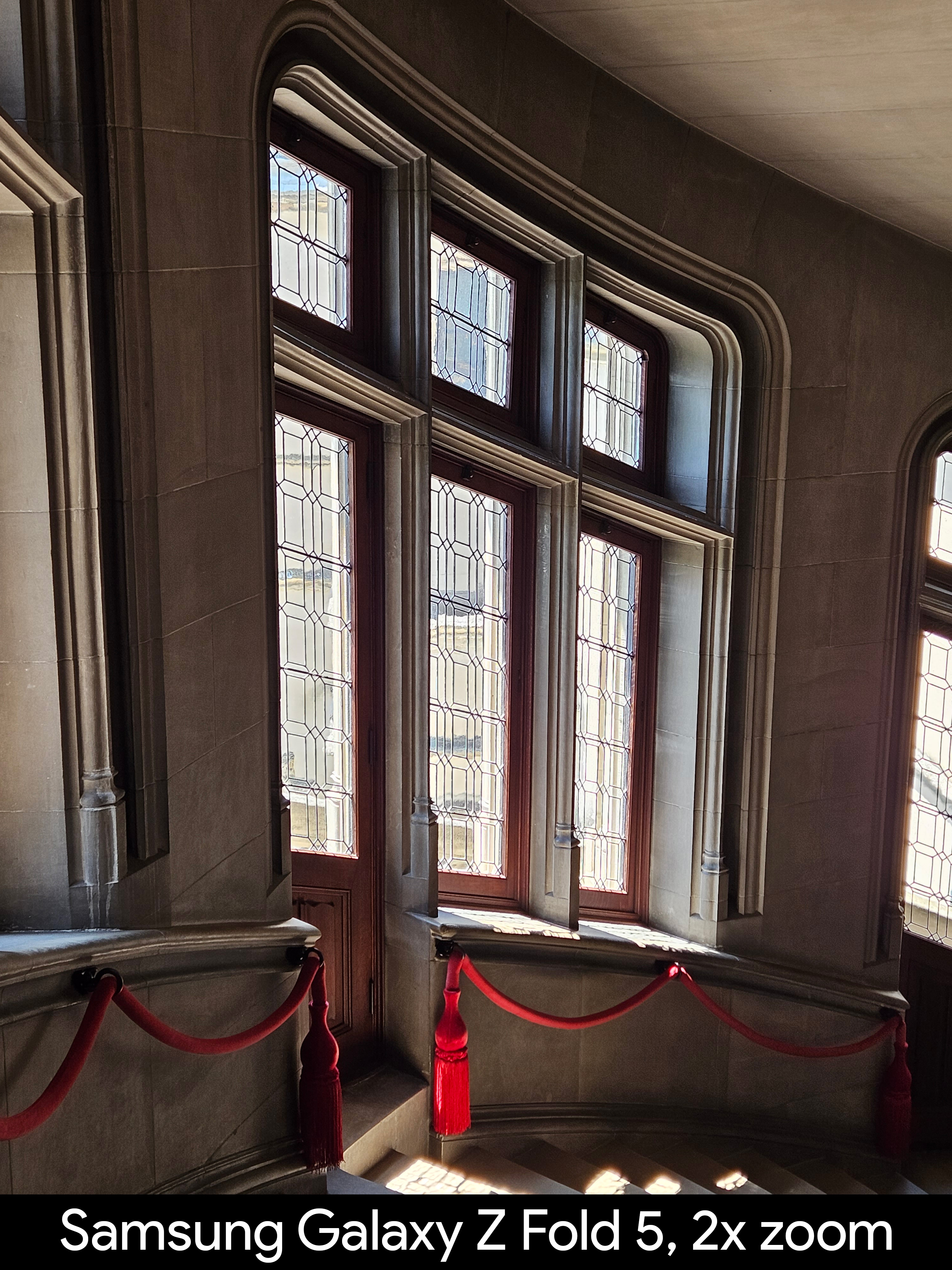

This sample — taken at 2x zoom via the quick button on the viewfinder — yet again showcases the excellent work Samsung has done in retaining fine detail when difficult scenes are shot. Typically, scenes like this with lots of backlighting end up scrubbing detail away from objects in the scene. You can see in both the Pixel Fold and Z Fold 4 shots that the bricks look smooth and without texture.
But the Z Fold 5's shot proves that these bricks are actually a bit rough and have lots of fine texture detail. Google has better white balance and slightly better dynamic range, but I'd rather have the extra detail if I had to choose between them.



In lower light, the Z Fold 5 gets a little too ambitious for its own good. This doesn't always happen with the Fold 5, but I pointed out these same kinds of weird ultrabright situations in the Galaxy S23 Ultra camera review earlier this year.
So far, the Fold 5 hasn't produced anywhere near the strangely high percentage of inconsistencies that the S23 Ultra had, which means Samsung seems to have figured out what's causing this most of the time.
Both the Fold 4 and Pixel Fold did an admirable job of capturing the scene — which is incredibly dim — and the Pixel Fold got the best white balance again, even if it wasn't as stark a contrast as the previous example. The Pixel Fold also has better fine detail and better dynamic range, with less blooming on light sources.



Taking selfies with the rear camera is one of the coolest things you can do with a foldable phone. As such, I tried out the portrait mode in a difficult situation for a camera: the phone was in the shade while I knelt in the sun with the light behind me.
Both the Fold 4 and Fold 5 had a very hard time getting this one right. Both phones blurred my shoulders out of the shot, and neither was able to properly light my face. The Pixel Fold, on the other hand, got the shot almost perfect.
The only problem in the Pixel Fold's shot is the right side, where it failed to blur the concrete wall behind me to the same degree it blurred it on the left side.
But Samsung's portrait mode is second to none in this industry, and it's clear from the moment you look at shots like the one above. Over the years, Samsung has evolved its portrait mode to cover the gamut of shots, from photos of people to pets and anything in between.
The distinction between foreground and background here is unparalleled, and you'd have a hard time telling the difference between a shot like this and a similar one taken from a DSLR camera. It really is that good, and it's that good the vast majority of the time.
Samsung Galaxy Z Fold 5: Motion
Samsung cameras always struggle to capture objects in motion, and unfortunately for Samsung owners, the Fold 5 isn't any different. In my usual test, my son jumps off the couch, and I take a photo of him with two phones at the same time.
Each phone's shutter button is pressed at the same time, and the differences between the pictures are simply down to processing differences between the phones. I take four pictures with each pair of phones and check each for the results.

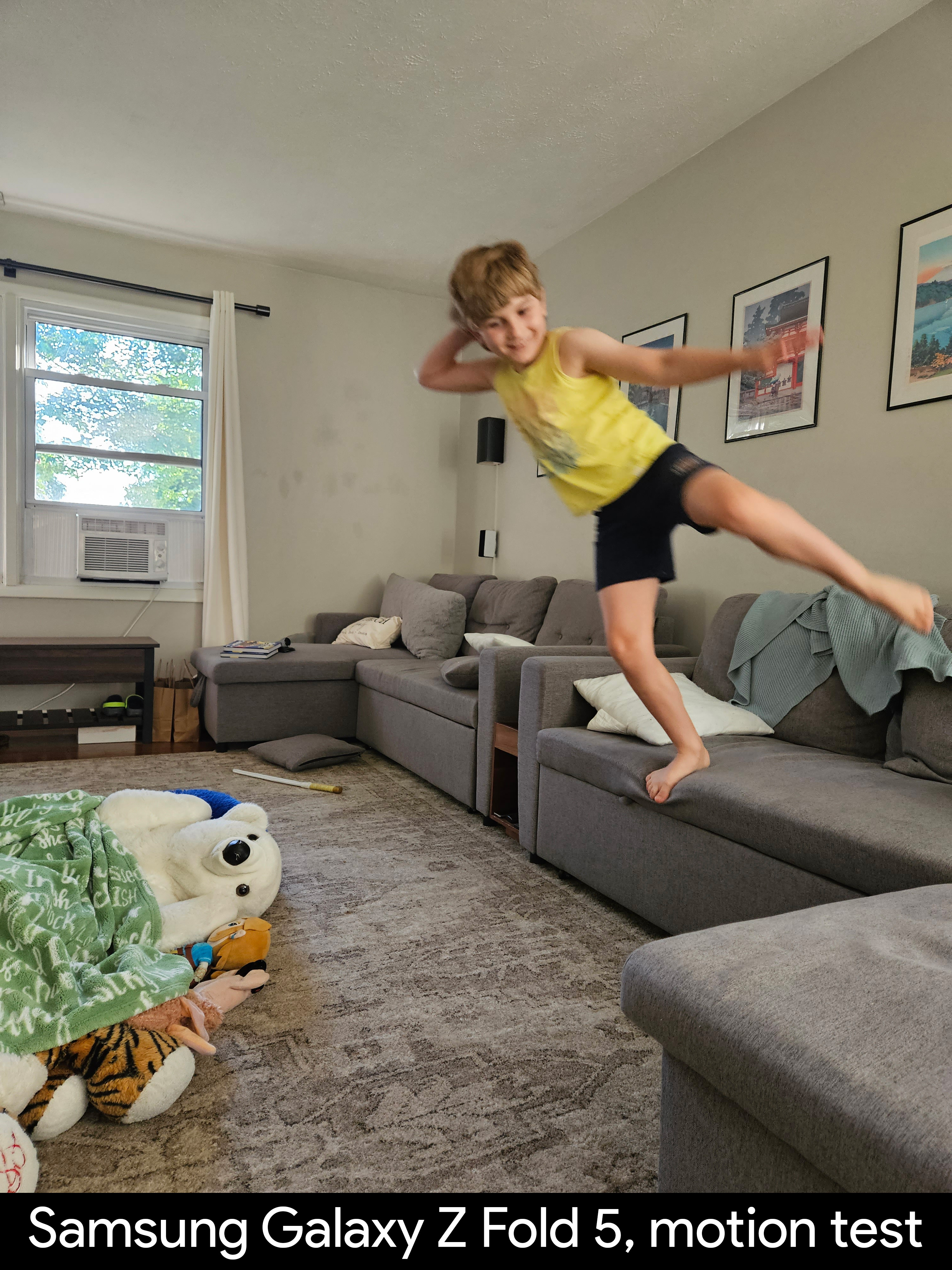


In this test, all four of the Z Fold 5's photos were blurry. None of them captured a clear face at all, although you could at least get an idea of who the person was if you knew him in most of the shots.
The Pixel Fold fared much better, and only one of the four could be categorized as extremely blurry. In both cases, though, neither phone did an exemplary job on this test.
Compare this to the Pixel 7, and you'll immediately see the difference. All four Pixel 7 shots are effectively perfect, capturing the moment without blur and with a crisp face.

It's always surprising to see how well Google does on these tests and at least a little surprising to see the Pixel Fold fare so poorly. It is worth noting that the Pixel Fold does not use the same sensors as the Pixel 7, though.
But here's the kicker. Google's "Top Shot" feature, as seen above, lets me pick a better photo that was automatically taken before and after I actually tapped the shutter button. In this way, I can still get a photo that's clear and usable from the Pixel Fold, even if I have to hit the "edit" button to get it. With the Z Fold 5, there's no way to choose a better photo.
Samsung Galaxy Z Fold 5: Telephoto camera
Samsung reserves the best telephoto camera quality for its Ultra line, but that doesn't mean the Z Fold 5 is any slouch. Sure, it's only got a 3x optical telephoto lens, but this year, Samsung is utilizing that big 50MP main sensor more often to help bring in more detail to zoomed-in shots.
In some cases, this can mean a night and day difference between the Z Fold 4 and Z Fold 5. There's never a scenario where the Z Fold 5 doesn't pull in more detail than the Fold 4 at the same zoom levels.
As we might expect, the Google Pixel Fold's 5x optical telephoto lens is able to pull in more detail no matter the scenario but let's focus on a few daytime shots first.
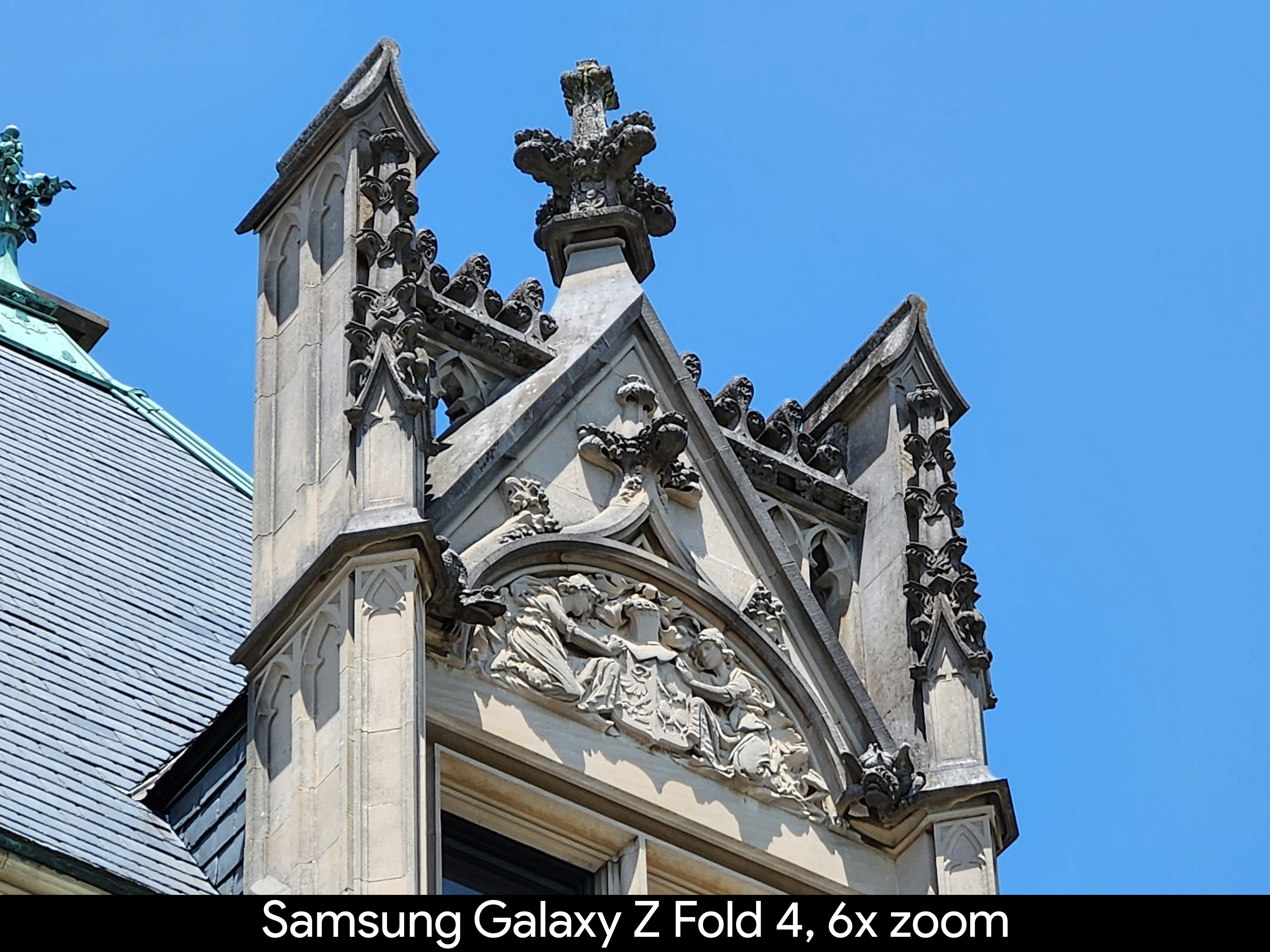





As you can see, the Fold 5 does a great job of pulling in more detail, but the Pixel Fold creates the most detailed, well-balanced photo of the three phones.
The second example above is particularly interesting because it shows that the more aggressive hybrid methodology on the Z Fold 5 doesn't always make a nicer-looking image, even if it looks more natural and less like a digitally-cropped photo than what the Fold 4 creates.
In many cases, you can tell when Samsung's "Space Zoom" hybrid zoom feature kicks in when the contrast pumps up, and there's fringing and chromatic aberration in the image.






Zooming in further to the Pixel Fold's maximum distance of 20x actually reduces the gap between these phones, surprisingly. The Pixel Fold still produces the best shot at all zoom levels — look at the texture on the stone in the top right of the first example or the roof tiles in the second example — but the difference between the Z Folds and Pixel Fold is less severe than at lower zoom levels.
Zooming in to 30x with the Z Fold 4 and Z Fold 5 — the maximum zoom level of each phone — doesn't change anything. The Pixel Fold is still able to pull out more detail and a more balanced shot by just cropping a 20x image after you take it.


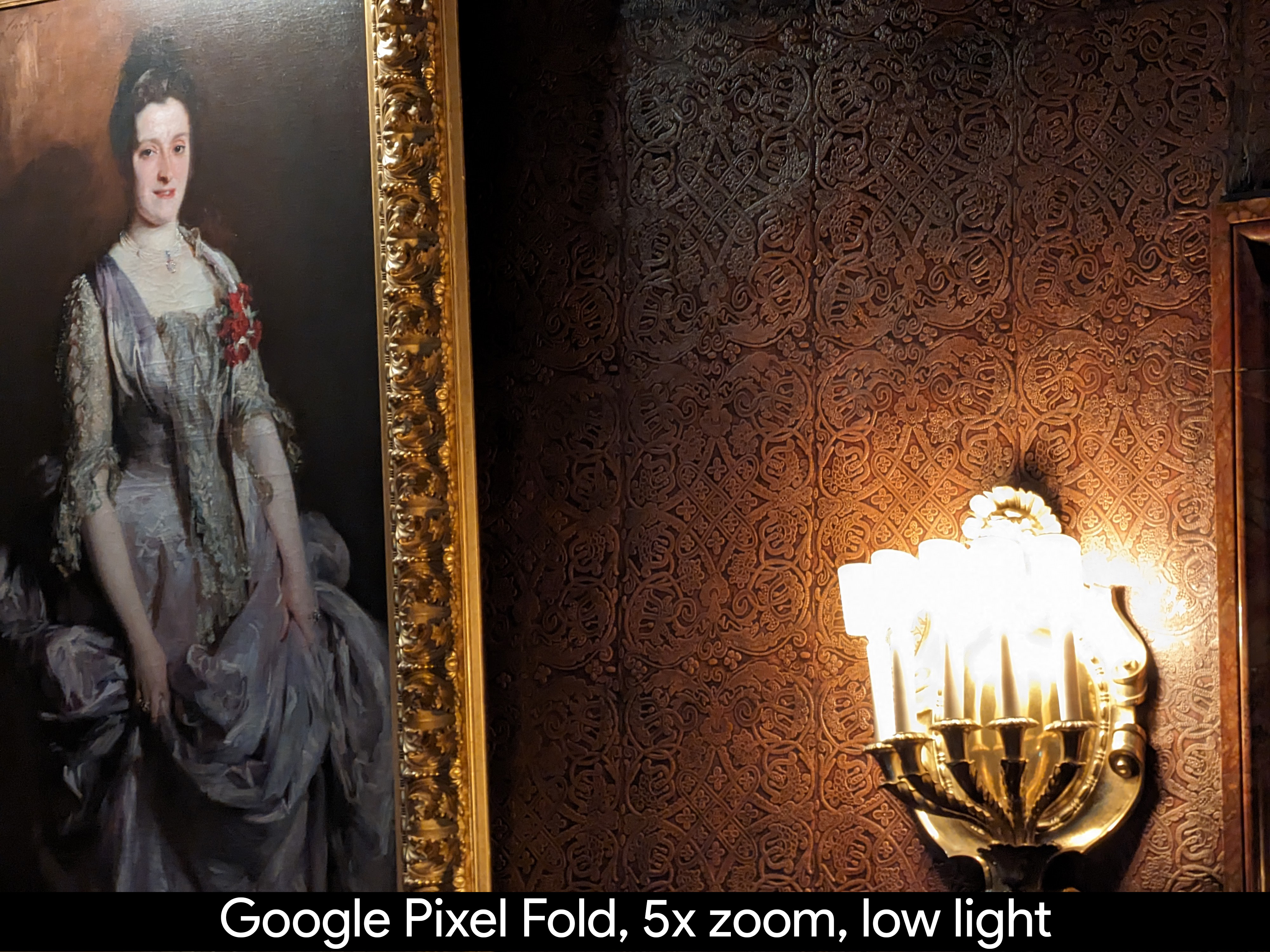



Telephoto performance in low light was downright surprising, to say the least. The first example is the most extreme, showing the Z Fold 5 handily beating both the Z Fold 4 and Pixel Fold by a wide margin. Everything is better, from fine detail to exposure, highlights, dynamic range, and even white balance.
The second example goes back to Samsung's habit of making low light photos too warm for their own good. The Z Fold 5 pulls in a little more detail than the Z Fold 4 but not anything really worth pointing out. The Pixel Fold pulls out the most detail but it's so noisy that I can see people preferring Samsung's photo for that reason alone.
Samsung Galaxy Z Fold 5: Ultrawide camera
Samsung utilizes a 12MP sensor for its ultrawide camera on the Z Fold 4 and 5, while Google opts for a lower-resolution 10.8MP sensor on the Pixel Fold. While all three phones sport lenses with identical ƒ/2.2 aperture, the Pixel Fold's ultrawide camera has bigger pixels — 1.25μm compared to the 1.12μm on the Z Fold 4/5.
The small difference on paper makes a dramatic difference in practice, especially as the light dips lower.

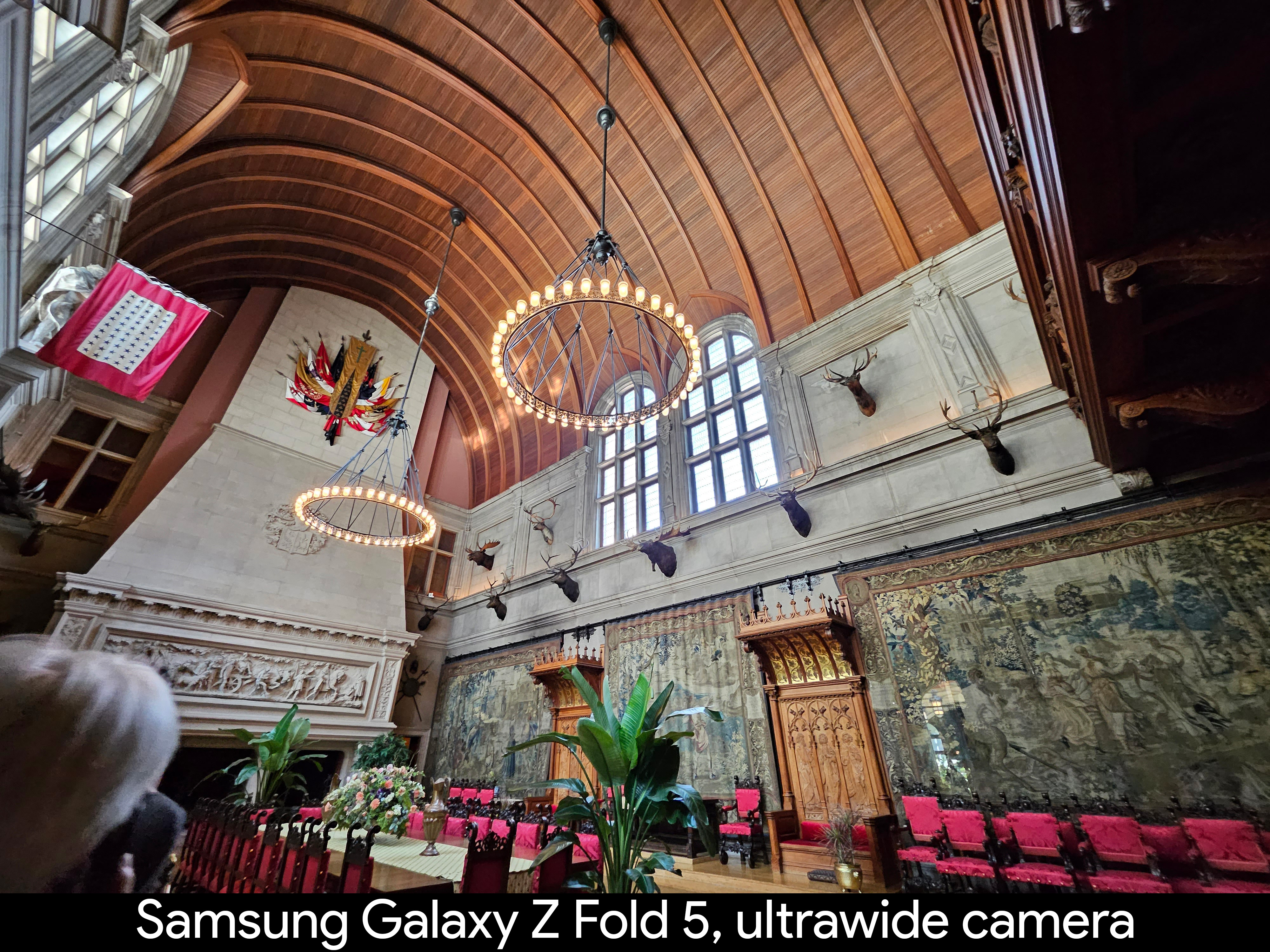




In the first example, the Pixel Fold's photo is slightly noisier — especially in the top left and other heavily shadowed areas — but overall looks more detailed and more correctly lit. As has been the case in most lower light photos, the Pixel Fold's white balance is also correct, while the Z Fold 4/5 are both too warm.
The Z Fold 5 produces slightly better dynamic range than the Z Fold 4 but ties with the Pixel Fold depending on where you're looking in the scene. The Fold 5 captures the bright window details, while the Pixel Fold does a better job on the chandelier.
In the second example, the Pixel Fold does a better job of capturing the deep blue of the sky outside, but other than that, all three phones did a nice job of capturing the well-lit scene.
Samsung Galaxy Z Fold 5: Front-facing cameras
The Z Fold 5 uses the same cover and under-display cameras as the Z Fold 4, but Samsung has made a number of software tweaks that genuinely improve the camera quality, starting with a slightly different final capture resolution.
By default, the Z Fold 4's cover camera captures at 2004 x 2672 resolution, while the same camera on the Z Fold 5 captures at 2080 x 2784 resolution. This minor bump in resolution makes a surprising difference in overall quality and seems to avoid that strange pixel stretching/pixelation issue that the Fold 4's cover camera has from time to time. Look at the first backlit example to see what I mean.
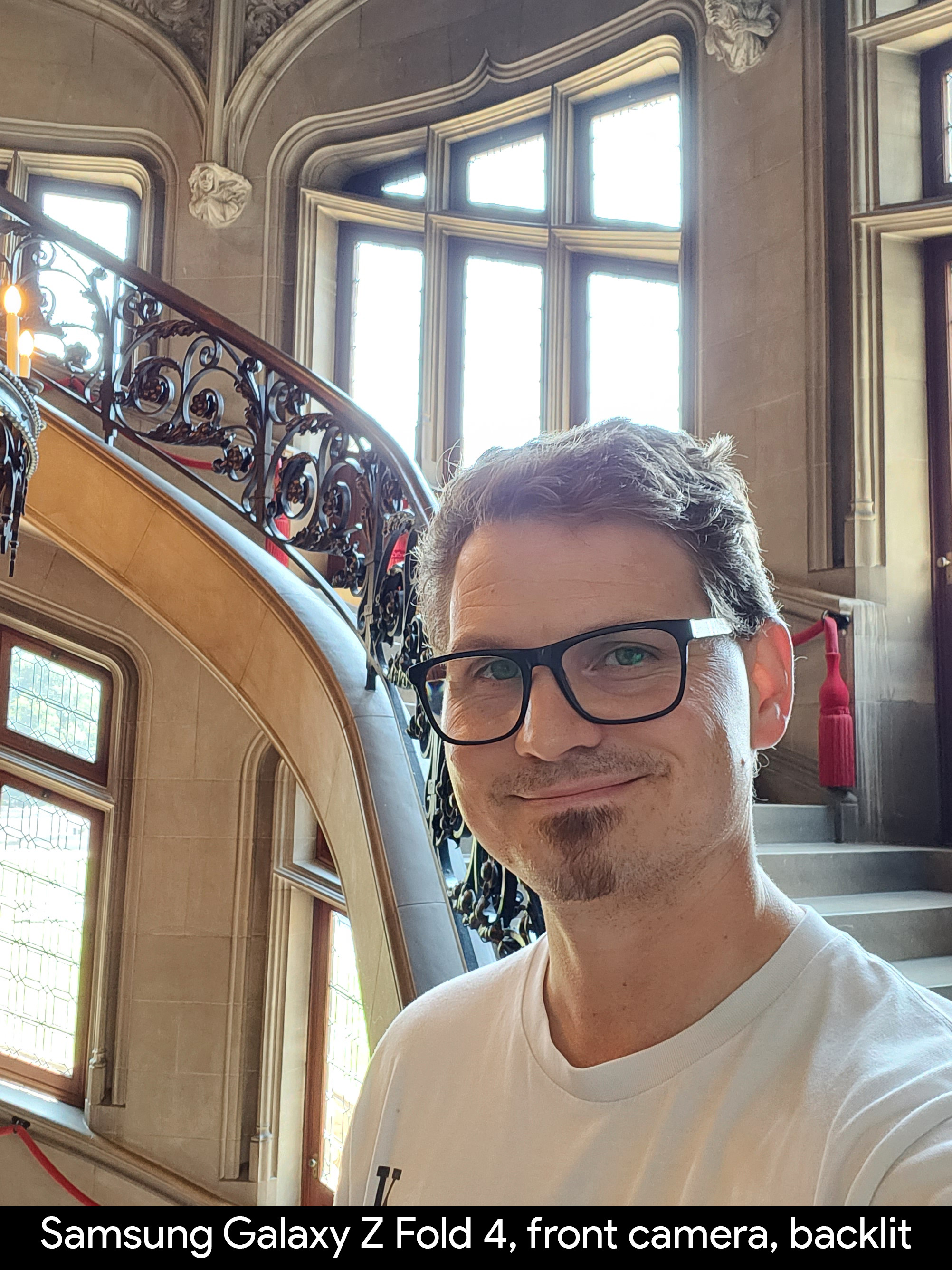

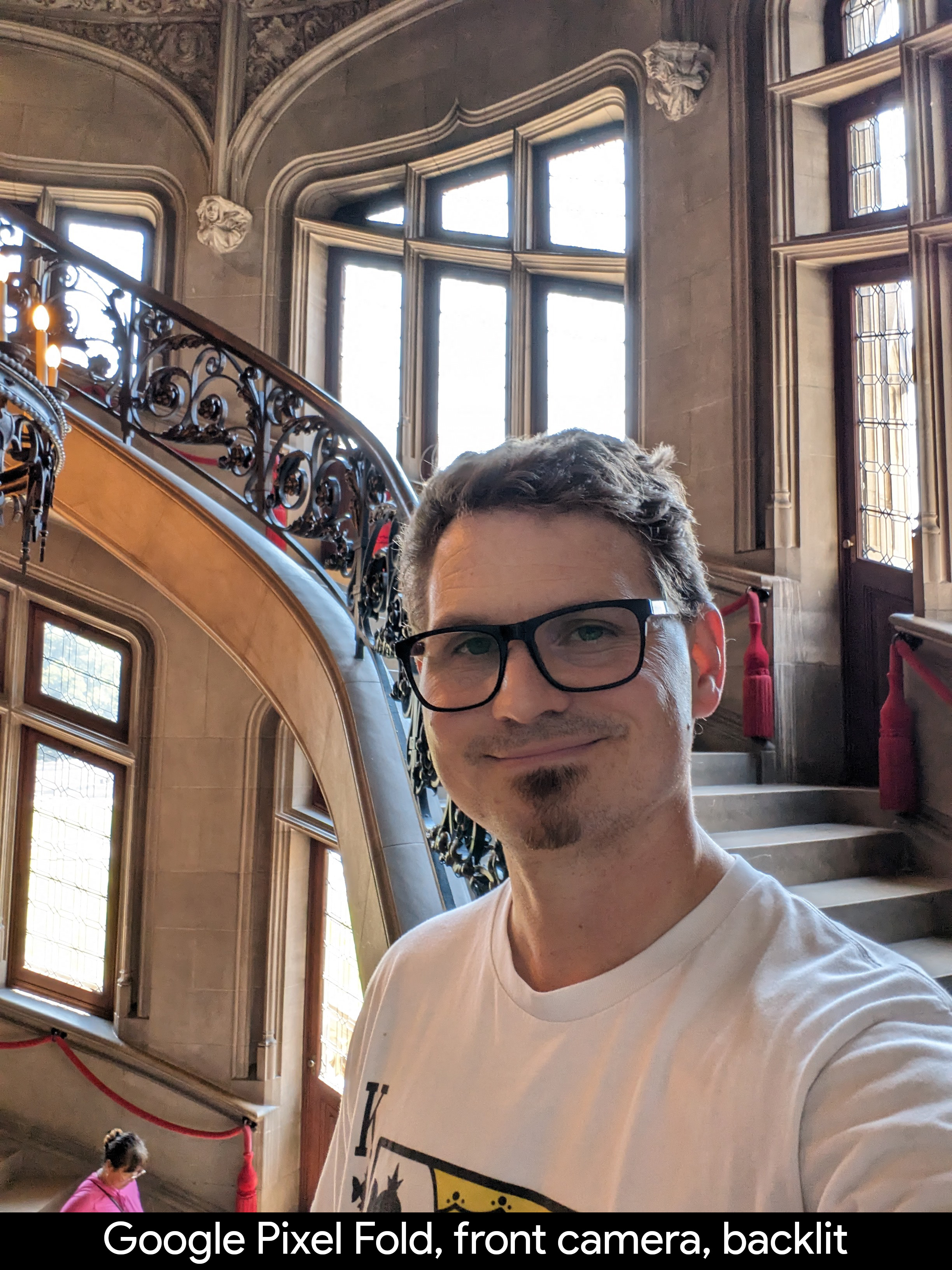



While the Z Fold 5 doesn't do any better handling the bright backlit scene than the Fold 4, the resolution difference makes the image look much crisper and nicer overall. The Pixel Fold does a better job of both contrast and toning down the glow from the bright windows and looks better, in general.
In the second example, the lower lighting conditions get the best of the Pixel Fold's front-facing camera, and it comes out looking the worst of the three. The lighting looks more natural in the Pixel Fold's shot — I'm a bit unnaturally bright in the Z Fold 4/5 shots — but Samsung's camera does a better overall job.
The Z Fold 5, in particular, really nailed the details in the scene and did a stellar job of picking up the floor texture and other fine detail all over the place. Plus, I'm most in focus in the Z Fold 5's shot despite none of these selfie cameras having autofocus.
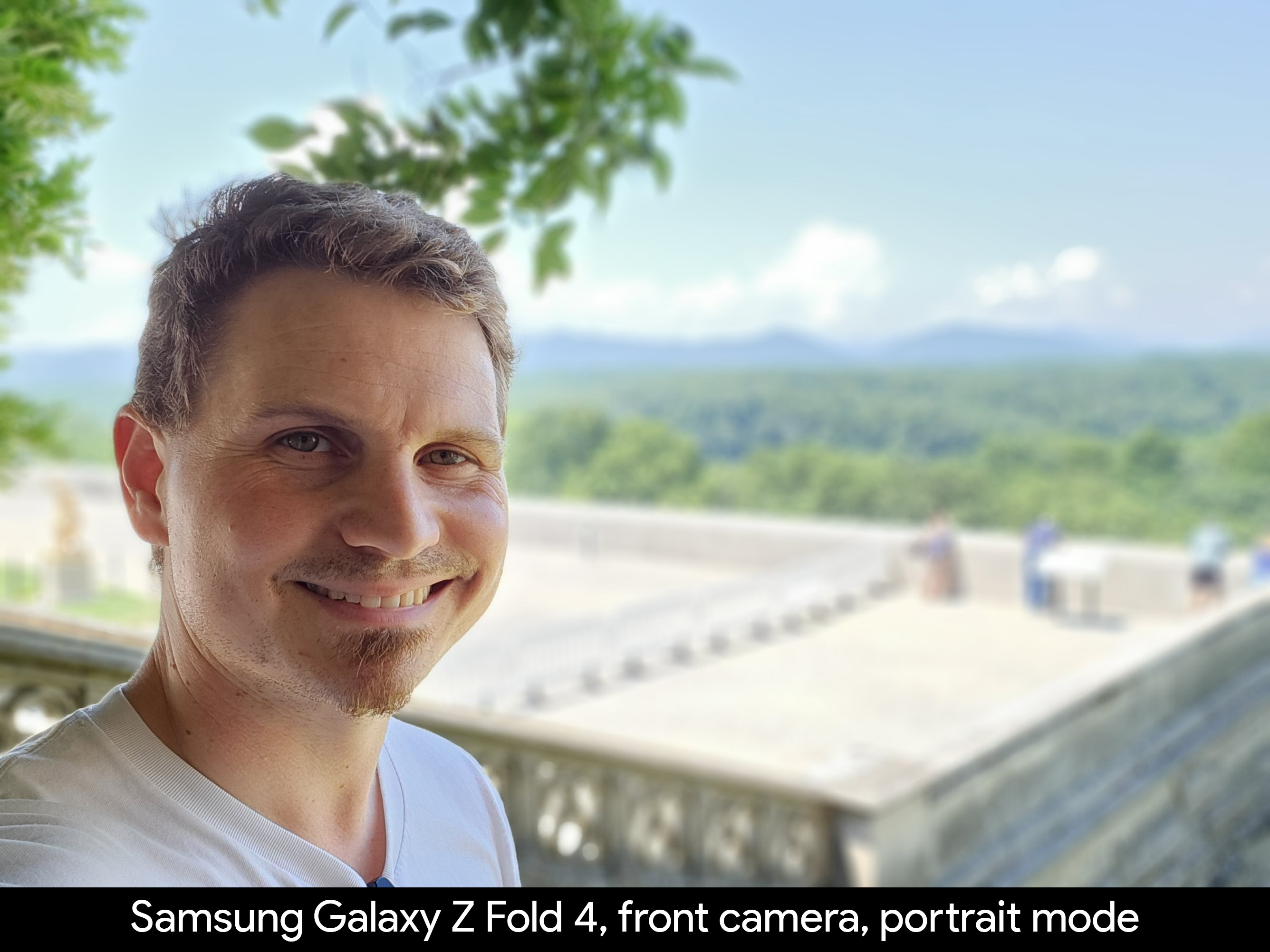

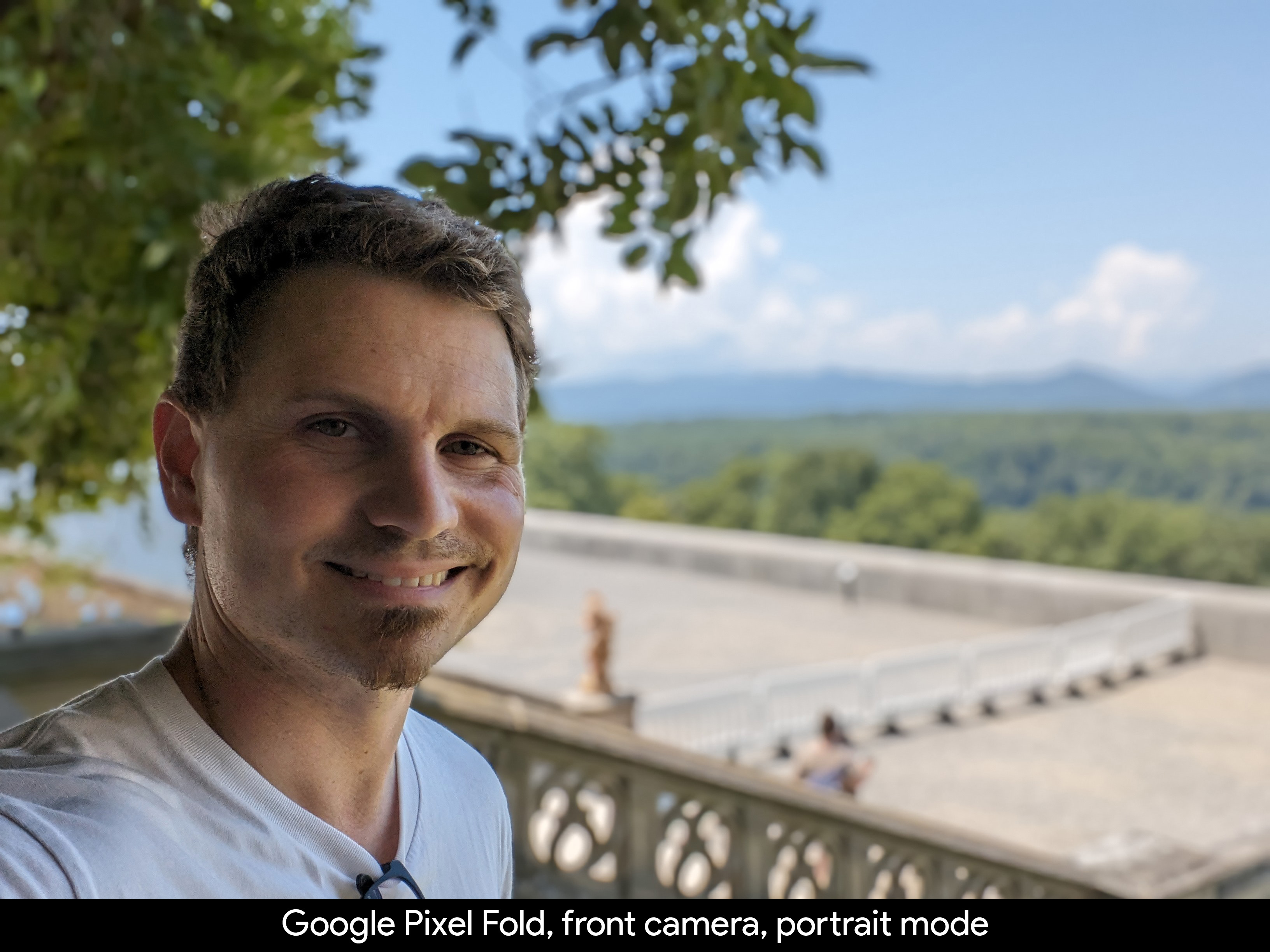



These next two shots use the portrait mode on the front-facing camera. This was taken under the cover of shade with a bright backdrop, which is particularly difficult in portrait mode because the phone has to identify the foreground, light it properly, then isolate it from the background with a blur.
As usual, Samsung's blur cut-outs are better than Google's, but this example isn't as severe as some others I've seen out of Pixel phones. I far prefer the Pixel Fold's overall exposure in this shot, but Samsung prioritized the exposure of my face instead of the background. This one's probably going to be down to preference instead of superiority, although it's worth noting that my face in the Pixel Fold's shot is a bit noisy.
The second example of me holding my hand up shows how bad portrait mode usually is on Pixel phones. I'm not sure why it struggles so much, given Google's AI prowess, but the cut-out is downright terrible. There are tons of artifacts on my hand and all around my head as the phone struggles to figure out what should be blurred. Samsung slayed here.


The under-display camera on the Z Fold 5 might be identical to the Z Fold 4's, but the algorithm used does a better job of cleaning up the image. The differences are minute, at best, but seeing improvement on the phone's worst camera is always a plus.
Still, I wouldn't recommend using this camera for more than video calls, especially outside. Any time there's a lot of bright light around, the quality is very bad, with lots of bloom and visual artifacts due to the fact that the camera has to see through the display.
Samsung Galaxy Z Fold 5: Video recording
Video recording is an area where Samsung has always traditionally excelled, and Google has always traditionally fallen behind. Nothing changes in that respect with the Galaxy Z Fold 5 vs Pixel Fold. I'm only using one video example here for the sake of brevity, but the results from all cameras are the same.
Samsung's video recording quality is better from head to toe. Video and overall details are sharper, exposure is better, stabilization is better, and even audio recording quality is better. The Pixel Fold's video is noisier than the Fold 5 in low light. While the difference isn't severe, there's no denying the Fold 5 does a better job of recording video from any angle.
Zooming in with the rear camera is a little less cut and dry. In the video above, I compare the Z Fold 4, Z Fold 5, and Pixel Fold by zooming in and out several times in succession. The difference between the Fold 4 and Fold 5 is pretty minimal, although it looks like Samsung further tweaked the phone's ability to smoothly switch between cameras while zooming.
Meanwhile, the Pixel Fold has a harder time approximating the same spot when zooming in and out. There's a very clear jump when the phone moves between the ultrawide, main, and telephoto lenses. The Z Fold series does a much better job of smoothing these transitions out.
Google wins the zoom detail test, though, as the 5x optical lens on the back offers a clearer image. Plus, the Pixel Fold can zoom in up to 20x via the viewfinder, while the Galaxy Z Fold 4/5 are both restricted to a maximum of 12x zoom when recording video.
Samsung Galaxy Z Fold 5: Additional notes

This year, there's no difference in the camera software between generations, save for one important thing: shutter speed. Samsung phones have long been plagued with shutter lag, which is defined by the time it takes between pressing the shutter button and being able to take the next photo.
Even the best Samsung phones could see a delay of a full second or more between shots, making it easy to miss capturing the right moment if the phone decides to "act dumb," as I've heard many people say. Thankfully, the Z Fold 5 seems to finally fix that age-old problem, as evidenced by this video I made.
That's some great news for Samsung owners and, combined with the rest of the improvements here, spells out another solid camera entry for Samsung. The Pixel Fold eclipses the Galaxy Z Fold 5 in many tests, but Samsung's largest foldable definitely holds its own plenty of times, as well.
But the improvements here probably aren't worth upgrading over the Z Fold 4, especially if you can get a great Galaxy Z Fold 4 deal.



